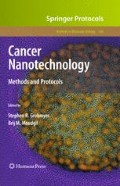Abstract
During nanoparticle system in drug delivery, liposomes were perhaps the best characterized and one of the first to be developed. Stealth liposomes (SLs), containing polyethylene glycol-conjugated lipid, which can form a hydro-layer around liposomes bilayer, have a long circulation time and hence result in enhanced drug efficiency. Doxorubicin (DOX), an effective anticancer drug, can be loaded into liposomes by transmembrane pH gradient method to get high encapsulation efficiency with high drug/lipid ratio. Liposomal doxorubicin is a successful clinical formulation, and also a perfect model drug system for cancer-therapy research. Here we described the preparation of SLs via extrusion, DOX loading by transmembrane pH gradient method, and characterization analysis, including phospholipid concentration, size, transmission electronic microscopy graph, encapsulation efficiency, and in vitro drug release.
Access this chapter
Tax calculation will be finalised at checkout
Purchases are for personal use only
References
Mayer, L. D., Bally, M. B., and Cullis, P. R. (1986) Uptake of adriamycin into large unilamellar vesicles in response to a pH gradient. Biochim Biophys Acta 857(1), 123–126.
Madden, T. D., Harrigan, P. R., Tai, L. C., Bally, M. B., Mayer, L. D., Redelmeier, T. E., Loughrey, H. C., Tilcock, C. P., Reinish, L. W., and Cullis, P. R. (1990) The accumulation of drugs within large unilamellar vesicles exhibiting a proton gradient: a survey. Chem Phys Lipids 53(1), 37–46.
Schneider, T., Sachse, A., Rößling, G., and Brandl, M. (1994) Large-scale production of liposomes of defined size by a new continuous high pressure extrusion device. Drug Dev Ind Pharm 20, 2787–2807.
Schneider, T., Sachse, A., Röβling, G., and Brandl, M. (1995) Generation of contrast-carrying liposomes of defined size with a new continuous high pressure extrusion method. Int J Pharm 117(1), 1–12.
Mrsny, R. J., Volwerk, J. J., and Griffith, O. H. (1986) A simplified procedure for lipid phosphorus analysis shows that digestion rates vary with phospholipid structure. Chem Phys Lipids 39, 185–191.
Berger, N., Sachse, A., Bender, J., Schubert, R., and Brandl, M. (2001) Filter extrusion of liposomes using different devices: comparison of liposome size, encapsulation efficiency, and process characteristics. Int J Pharm 223(1–2), 55–68.
Mayer, L. D., Bally, M. B., and Cullis, P. R. (1986) Uptake of adriamycin into large unilamellar vesicles in response to a pH gradient. Biochim Biophys Acta 857(1), 123–126.
Sivakumar, P. A. and Panduranga Rao, K. (2001) Polymerized (ethylene glycol) dimetha crylate-cholesteryl methacrylate liposomes: preparation and stability studies. React Funct Polym 49, 179–187.
Allen, T. M., Brandeis, E., Hansen, C. B., Kao, G. Y., and Zalipsky, S. (1995) A new strategy for attachment of antibodies to sterically stabilized liposomes resulting in efficient targeting to cancer cells. Biochim Biophys Acta 1237, 99–108.
Lasic, D. D., Frederik, P. M., Stuart, M. C., Barenholz, Y., and McIntosh, T. J. (1992) Gelation of liposome interior. A novel method for drug encapsulation. FEBS Lett 312, 255–258.
Abraham, S. A., Waterhouse, D. N., Mayer, L. D., Cullis, P. R., Madden, T. D., and Bally, M. B. (2005) The liposomal formulation of doxorubicin. Methods Enzymol 391, 71–97.
Author information
Authors and Affiliations
Editor information
Editors and Affiliations
Rights and permissions
Copyright information
© 2010 Springer Science+Business Media, LLC
About this protocol
Cite this protocol
Niu, G., Cogburn, B., Hughes, J. (2010). Preparation and Characterization of Doxorubicin Liposomes. In: Grobmyer, S., Moudgil, B. (eds) Cancer Nanotechnology. Methods in Molecular Biology, vol 624. Humana Press. https://doi.org/10.1007/978-1-60761-609-2_14
Download citation
DOI: https://doi.org/10.1007/978-1-60761-609-2_14
Published:
Publisher Name: Humana Press
Print ISBN: 978-1-60761-608-5
Online ISBN: 978-1-60761-609-2
eBook Packages: Springer Protocols

